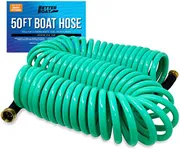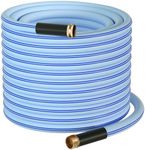We Use CookiesWe use cookies to enhance the security, performance,
functionality and for analytical and promotional activities. By continuing to browse this site you
are agreeing to our privacy policy
Best Expandable Garden Hose
From leading brands and best sellers available on the web.How do we rank products for you?
Our technology thoroughly searches through the online shopping world, reviewing hundreds of sites. We then process and analyze this information, updating in real-time to bring you the latest top-rated products. This way, you always get the best and most current options available.

Most Popular Categories Right Now
Buying Guide for the Best Expandable Garden Hose
Choosing the right expandable garden hose can make your gardening tasks much easier and more enjoyable. An expandable garden hose is designed to expand in length when water is turned on and contract back to its original size when the water is off, making it lightweight and easy to store. To find the best fit for your needs, consider the following key specifications and their importance.LengthThe length of the hose determines how far it can reach when fully expanded. This is important because it dictates how much area you can cover without needing to move the hose or connect multiple hoses. Expandable hoses typically come in lengths ranging from 25 feet to 100 feet. If you have a small garden or patio, a shorter hose (25-50 feet) may be sufficient. For larger yards, a longer hose (75-100 feet) will provide better coverage.
MaterialThe material of the hose affects its durability and flexibility. Most expandable hoses are made from a combination of latex and polyester. The inner tube is usually made of latex, which is flexible and can expand without breaking, while the outer layer is made of polyester to protect the inner tube. Look for hoses with double or triple-layer latex for added durability. If you need a hose that can withstand rough handling or extreme weather conditions, opt for one with a thicker and more robust outer layer.
FittingsFittings are the connectors at the ends of the hose that attach to the water source and any attachments like nozzles or sprinklers. High-quality fittings are crucial for preventing leaks and ensuring a secure connection. Fittings are typically made from plastic, aluminum, or brass. Brass fittings are the most durable and resistant to corrosion, making them a good choice for long-term use. If you need a hose for heavy-duty use, opt for brass fittings. For lighter use, plastic or aluminum fittings may suffice.
WeightThe weight of the hose affects how easy it is to handle and maneuver. Expandable hoses are generally lighter than traditional rubber hoses, making them easier to carry and store. If you have limited strength or mobility, a lighter hose will be more manageable. Check the weight specifications to ensure the hose is easy for you to handle, especially when it is filled with water.
Nozzle CompatibilityNozzle compatibility refers to whether the hose can easily connect to various types of nozzles and attachments. This is important for versatility in watering tasks, such as gentle watering for delicate plants or a strong spray for cleaning tasks. Most expandable hoses come with standard-sized fittings that are compatible with a wide range of nozzles. Ensure the hose you choose can connect to the nozzles you plan to use, or consider purchasing a hose that comes with a multi-function nozzle.
Storage and MaintenanceStorage and maintenance considerations include how easy it is to store the hose when not in use and how to care for it to extend its lifespan. Expandable hoses are designed to be compact and easy to store, often shrinking to a fraction of their expanded size. Look for hoses that come with a storage bag or hanger for convenience. To maintain your hose, avoid leaving it in direct sunlight for extended periods and drain it after each use to prevent mold and mildew. If you need a hose that requires minimal maintenance, choose one with a durable outer layer and high-quality fittings.













